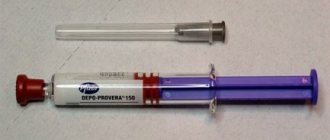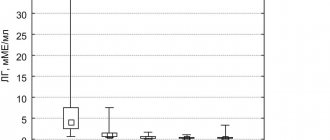Instructions for use MODITEN® DEPO
Acute dystonic reactions
occur infrequently and, as a rule, during the first 24-48 hours; Delayed reactions are possible. In susceptible patients, these phenomena may appear after using the drug in low doses and include oculogyric crisis and opisthotonus. To alleviate the condition, an antiparkinsonian drug, procyclidine, is administered intravenously.
Parkinson-like conditions
may appear between 2 and 5 days after injection, and usually decrease with subsequent administration of the drug. The likelihood of this type of reaction can be reduced by prescribing the drug in lower doses with increasing frequency of dosing or by concomitant use of antiparkinsonian drugs (trihexyphenidyl, benzatropine or procyclidine). These drugs should not be prescribed regularly due to the risk of exacerbating anticholinergic side effects, provoking states of confusion, or impairing the therapeutic effectiveness of Moditen® Depot.
With careful dose selection, the number of patients eligible to take antiparkinsonian drugs can be minimized.
Tardive dyskinesia
possible in some patients with long-term therapy with antipsychotic drugs or after cessation of treatment. An increased risk was observed in elderly people, especially women, when the drug was prescribed in high doses. Symptoms are persistent and in some cases irreversible. Tardive dyskinesia manifests itself in the form of rhythmic involuntary movements of the tongue, muscles of the face or neck (tongue protruding, puffing out of the cheeks, grimacing, chewing movements), in some cases, involuntary movements of the limbs are possible. There is no effective treatment for tardive dyskinesia. If these symptoms occur, it is recommended to stop taking the antipsychotic drug. When resuming treatment, increasing the dose of the drug, or replacing one antipsychotic with another, symptoms may be masked. It is also noted that worm-like movements of the tongue are an early sign of the disease, which does not develop if treatment is stopped at this stage.
Other adverse events
When taking phenothiazine drugs, drowsiness, lethargy, blurred vision, dry mouth, constipation, difficulty or involuntary urination, a slight decrease in blood pressure, impaired intellectual abilities, and epileptic seizures are sometimes observed.
Headache, nasal congestion, vomiting, emotional agitation, insomnia and hyponatremia were also observed during phenothiazine treatment.
There have been rare reports of pathological changes in the blood when using phenothiazine derivatives. If a patient develops signs of persistent infection, a blood test should be performed. Transient leukopenia and thrombocytopenia have been reported; in rare cases, the appearance of antinuclear antibodies and SLE.
There are rare reports of jaundice. At the same time, transient deviations from the norm in liver function tests can be obtained in the absence of this syndrome.
There have been reports of rare cases of transient increases in serum cholesterol in patients taking fluphenazine orally.
Skin pigmentation and lens opacification have sometimes been observed after long-term use of drugs of this class in high doses.
Phenothiazine is known to cause photosensitivity reactions, but no such reports have been received for fluphenazine. Hypersensitivity reactions (anaphylactic reactions) are sometimes possible.
Elderly patients may be more sensitive to sedative and hypotensive effects.
The effects of phenothiazine on the heart are dose dependent. Changes in the ECG with prolongation of the QT interval and changes in the T wave are possible when using the drug in moderate and high doses; patients reported previous severe arrhythmias, including paroxysmal ventricular tachycardia and ventricular fibrillation. There have been cases of sudden death in hospitalized patients receiving phenothiazine.
There are known cases of venous thromboembolism, incl. pulmonary embolism and deep vein thrombosis associated with antipsychotic drugs - frequency unknown.
Phenothiazine drugs may interfere with body temperature regulation. Elderly patients or patients with hypothyroidism may be especially sensitive to hypothermia. Hot, humid weather or taking medications that interfere with sweating (eg, antiparkinsonian drugs) may increase the risk of hyperthermia.
In rare cases, patients treated with antipsychotic drugs have been diagnosed with neuroleptic malignant syndrome (NMS), characterized by hyperthermia and some or all of the following symptoms:
- muscle rigidity, disorder of the autonomic nervous system (labile blood pressure, tachycardia, sweating), akinesia and an altered state of consciousness, sometimes developing to stupefaction or coma. Leukocytosis, increased CPK, liver dysfunction and acute renal failure are also possible. In these cases, you should immediately stop taking antipsychotic drugs and provide intensive symptomatic therapy.
Hormonal effects of phenothiazine include hyperprolactinemia, galactorrhea, gynecomastia, oligomenorrhea, or amenorrhea. Sexual function may be impaired, and a false result may occur during a pregnancy test. There are also known cases of impaired ADH secretion.
There have been reports of edema occurring when taking phenothiazine.
Login to the site
According to the International Society for Human Rights, at least two million people became victims of punitive psychiatry in the USSR. “Sluggish schizophrenia” was the favorite diagnosis of Soviet psychiatrists not only for political dissidents, but also for vagabonds, army draft dodgers and religious dissidents. Haloperidol helped fight “socially dangerous” citizens of the Soviet Union. In modern Russia, neuroleptics are again in the service of the state. Only now, instead of “sluggish schizophrenia,” Russian psychiatrists diagnose “emotional personality disorder.” The FSIN system, closed from society, has become an excellent testing ground for a new punitive psychiatric revolution in the history of the country.
During a joint trip from the HRC with human rights activist Andrei Babushkin to the institutions of the Federal Penitentiary Service in the Omsk region in June of this year, we repeatedly heard from prisoners complaints that they were not only tortured with electric shock, water, beaten, raped, suspended, but also poisoned: with gas, poisoned water and food. They also inject the psychotropic drug Aminazine.
I must say that we were quite skeptical about the information about the persecution of prisoners. However, we found in the psychiatric department of regional hospital No. 11 (OB-11) of the Federal Penitentiary Service of Omsk a prisoner from IK-7, who by that time had been tied to the bed for five days and who, in our opinion, was absolutely healthy and not showed no aggression, forced us to look differently at such complaints from the prisoners.
Patient reviews
Now you know why Moditen Depot injections are given. Instructions for use, side effects and contraindications for the use of this solution were also discussed above.
According to patients who have previously taken various antipsychotics, the drug “Moditen Depot” acts much more effectively and relieves all the negative symptoms of schizophrenia. The administration of this medicine causes a stable and rather long-term remission.
The only disadvantage of this remedy is the huge number of side reactions. In the first days of therapy, some people experienced hyperthermia, hypertension and autonomic disorders. Also, many patients observed hyperkinesis of the muscles of the mouth and face, smacking movements of the tongue and lips. In addition, the use of this drug often caused depression of varying severity.
Overdose
Possible serious extrapyramidal disorders, a significant decrease in blood pressure, miosis, hypothermia, urinary retention, changes in the ECG and cardiac arrhythmias; sedation and disturbances of consciousness up to coma. antidote unknown. Treatment is symptomatic. Careful monitoring of the patient's condition is necessary. for arrhythmias, sodium bicarbonate and magnesium sulfate are effective. for extrapyramidal disorders - antiparkinsonian drugs. in case of severe hypotension, only norepinephrine (norepinephrine) can be prescribed. Epinephrine (adrenaline) will lower your blood pressure even further.
Drug kinetics
What pharmacokinetics are characteristic of the drug "Moditen Depot"? The instructions for use state that fluphenazine in the form of a high-molecular ester, oil solution and fatty acid is able to accumulate in fat depots and is also slowly released.
After intramuscular injection, the maximum concentration of this element in plasma is reached after 25 hours. In this case, fluphenazine binds to blood proteins by 90%.
The drug in question easily penetrates the placental barrier and passes through the blood-brain barrier, and is also not excreted from the body through hemodialysis.
Fluphenazine is completely and actively metabolized in the liver with the participation of enzymes of the cytochrome P450 system. It is excreted from the body along with bile and urine. The activity of the metabolites of this element has not been fully studied.
The half-life of fluphenazine is 7-10 days.
Prohibitions on use
The medication in question must not be used in the following cases:
- in severe cardiovascular diseases, including decompensated chronic circulatory failure and arterial hypotension;
- if the patient is hypersensitive to fluphenazine, as well as to other elements of the drug;
- with depressed central nervous system function and comatose states;
- during pregnancy;
- with skull trauma, as well as progressive systemic diseases of the spinal cord and brain;
- during feeding period;
- with impaired functioning of the liver and blood system;
- up to 12 years old.
special instructions
Moditene depot is not intended for short-term use (less than 3 months), and is ineffective in the treatment of behavioral disorders in mentally retarded patients. the drug is prescribed with great caution to patients with convulsive disorders, as it may lower the threshold for seizures or cause them, including a generalized epileptic seizure. Prescribe with caution to patients with cardiovascular diseases, since a significant decrease in blood pressure is possible. Elderly and debilitated patients are prescribed Moditene Depot at the least effective dose, since side effects may occur more often in this category of patients.
As with other phenothiazine derivatives, silent pneumonia may develop when taking fluphenazine.
If a patient is taking anti-parkinsonian drugs during treatment with Moditene Depot and abruptly stops using the latter, he should continue taking anti-parkinsonian drugs for several more weeks.
During pregnancy, the drug can be used only in cases where the potential benefit outweighs the potential risk to the fetus. Fluphenazine passes into breast milk, so breastfeeding should be discontinued during treatment.
Pharmacology
What medicinal properties are inherent in the drug "Moditen Depot"? Instructions for use, reviews claim that this is a long-acting antipsychotic medicine. It belongs to the group of polyvalent neuroleptics and exhibits pronounced antipsychotic properties, which are combined with some activating and antiemetic effects. This drug also has a moderate sedative effect.
What determines the effectiveness of the drug "Moditen Depot"? The instructions for use state that its antipsychotic effect is associated with the blockade of dopamine D2 receptors in the mesocortical and mesolimbic systems.
The sedative properties of this medication are moderate and are observed only when using high dosages of the solution. They are caused by blockade of adrenergic receptors in certain areas of the brain stem.
As for the antiemetic effect of this medicine, it is associated with the blockade of dopamine D2 receptors in the trigger zones of the vomiting center. It should also be noted that this drug exhibits a hypothermic effect due to the blockade of dopamine receptors in the hypothalamus.
How long does it take for Moditen Depot to start working? Instructions for use (a photo of the injection solution is presented in this article) states that the therapeutic effect of this medicine usually appears 25-72 hours after the injection. It should also be noted that the antipsychotic properties of the drug in question are most pronounced in the period from 49 to 97 hours after administration of the solution.
Application
Injected deep into the / m. the needle and syringe must be dry. The initial dose is usually from 12.5 to 25 mg moditene depot. subsequent doses and intervals between administrations are determined individually. Usually the interval between injections is from 15 to 35 days. if a dose above 50 mg is required, it is gradually increased by 12.5 mg. a single dose should not exceed 100 mg. Patients who have not previously received treatment with phenothiazine derivatives should first undergo treatment with injections of short-acting forms of the drug or Moditene tablets. If moditene is well tolerated, they can be transferred to moditene depot. The initial dose of 12.5 mg moditene depot is administered intramuscularly. if well tolerated, after 5–10 days the next dose can be prescribed - 25 mg. further changes in the dose and interval between administrations of the drug depend on the patient’s individual response to the treatment.
If the patient has already taken phenothiazine derivatives, they can be replaced with Moditen Depot without prior treatment with short-acting forms of drugs or Moditen tablets. In this case, an initial IM dose of 12.5 mg is again used to determine tolerability of the drug, then the dose is adjusted individually. Older patients should be prescribed lower doses - from 1/3 to 1/4 of the standard dose. If extrapyramidal disorders occur, antiparkinsonian drugs are prescribed.




